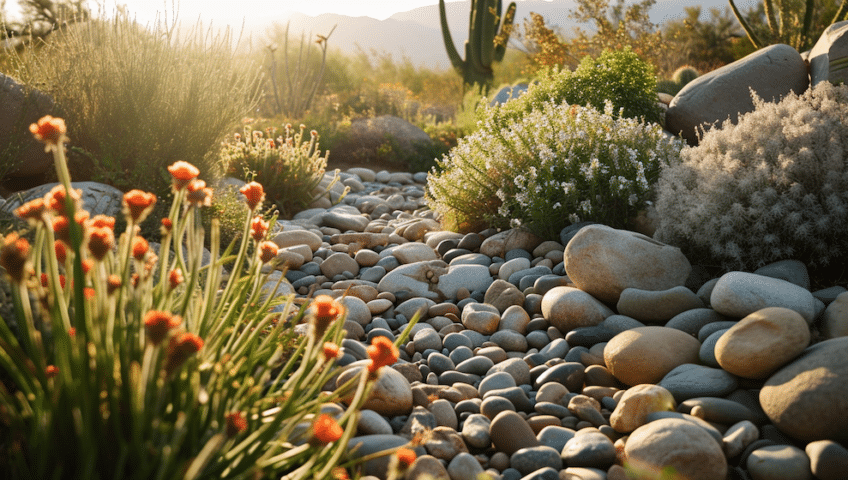Listen to the Article
Table of Contents
- Understanding Drought Tolerant Landscaping
- Designing a Water-Wise Landscape
- Tip #1: Look for Free Money First!
- Tip #2: Find out your Plant Hardiness Zone before selecting your plants
- Tip #3: Find native plants based on your Plant Hardiness Zone and region
- Tip #4: Cluster plants with similar watering needs for a water-efficient garden
- Tip #5: Incorporate permeable hardscape elements
- Essential Techniques for Conserving Water in Your Garden
- Innovative Ideas for Drought Tolerant Landscaping
- Summary
Are you struggling to maintain a sustainably green garden in the face of water scarcity? Drought-tolerant landscaping might just be the solution you’ve been searching for. With the right strategies, you can create a stunning, low-water garden that not only thrives in arid conditions but also conserves water and supports local ecosystems. In this blog post, we’ll explore several basic drought-tolerant landscaping strategies for creating a beautiful, sustainable outdoor space.
Key Takeaways
- Drought-tolerant landscape design conserves water and promotes biodiversity
- Native plants based on your Plant Hardiness Zone are an excellent choice for drought tolerance
- Building an efficient irrigation system, incorporating hardscape elements, and utilizing innovative technology can lead to a stunning sustainable garden
Understanding Drought Tolerant Landscaping
Drought-tolerant landscape design is an approach to outdoor spaces. It focuses on designs that can tolerate arid and water-scarce environments.
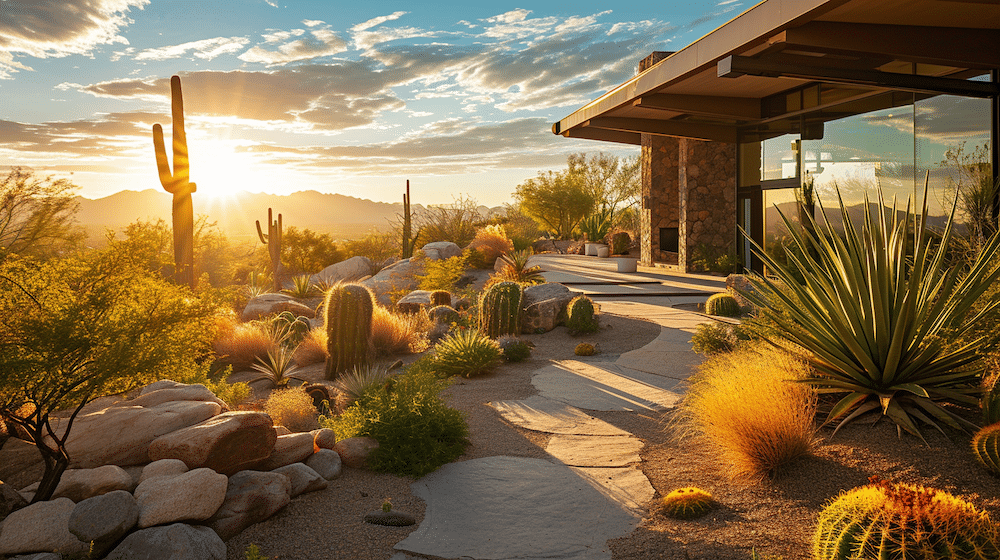
The importance of drought-tolerant landscaping lies in its ability to conserve water and sustain local ecosystems, making it an essential strategy in the face of climate change and diminishing water supplies. Implementing drought-tolerant landscaping ideas allows you to form a landscape that not only conserves water and reduces costs, but also promotes biodiversity. From using native plants and ground covers to covering bare ground and incorporating water features, there are numerous ways to create a drought-tolerant landscape that is both visually appealing and environmentally responsible.
Native Plants are a force for change. They beautify the landscape, nurture pollinators and other wildlife, save water, thrive in our local climate, prefer our soils, cut pesticide use, minimize your carbon footprint, reduce maintenance, can be installed at low cost, cool the environment, harmonize with diverse garden styles, and create a sense of place.
The Theodore Payne Foundation (LINK)
Focusing on water conservation and drought resistance enables the design of a landscape that requires minimal water and thrives under even the harshest conditions.Implementing drought resistant landscaping techniques, such as using native plants and drought-tolerant strategies, can help achieve this goal.
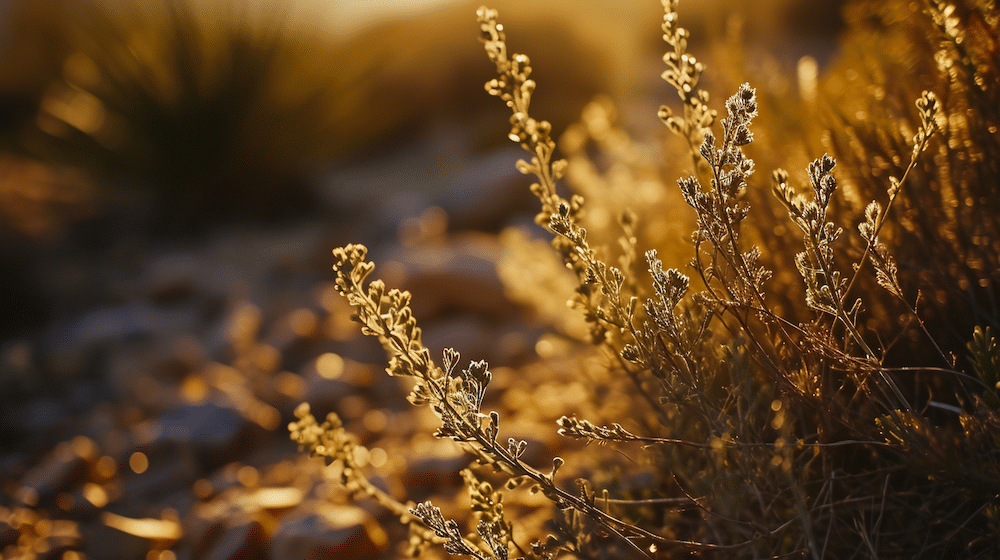
Designing a Water-Wise Landscape
Water-wise landscape design (aka water wise landscaping) incorporates drought-resistant plants, efficient irrigation, and hardscaping elements to minimize water usage in your yard. Selecting drought-tolerant plants like ornamental grasses and native plants enables the creation of a low maintenance landscape that requires less water.
Tip #1: Look for Free Money First!
As we covered in our article Turf Replacement Programs Explained, many state and city governments, as well as local water and energy agencies, are offering rebates for replacing your lawn with drought-tolerant landscaping. These rebates can be anywhere from $1 to $5 per square foot (even higher) as is evidenced by California’s generous budget for sustainable and water-wise gardens. Based on your square footage, your rebate could be enough to cover your entire project! The critical thing to remember is that these rebate programs require prior approval through a rebate application process. This means that if you don’t apply for the rebate before moving forward with your landscaping project, you will not be eligible.
Customers wishing to participate must first receive application pre-approval before beginning their replacement project. Residential customers can receive $5 per square foot on projects from 250 square feet to 5,000 square feet, for a total maximum rebate of $25,000.
Los Angeles Department of Water and Power – LADWP (LINK)
Tip #2: Find out your Plant Hardiness Zone before selecting your plants
Selecting the most suitable drought-resistant plants for your region is key to establishing a flourishing, low-water garden. These plants have adapted to survive in arid conditions and require less water than other plants. By selecting appropriate plants, you can conserve water and create a robust landscape that supports local ecosystems.
An essential step to choosing drought resistant plants is to check the Department of Agriculture’s Plant Hardiness Zone Map. Plant hardiness zones help gardeners figure out which plants can grow well in their area. The mapped zones each have their own kind of winter weather, where some areas are colder, and others are warmer. The zones are numbered: the lower the number, the colder that area gets in the winter.
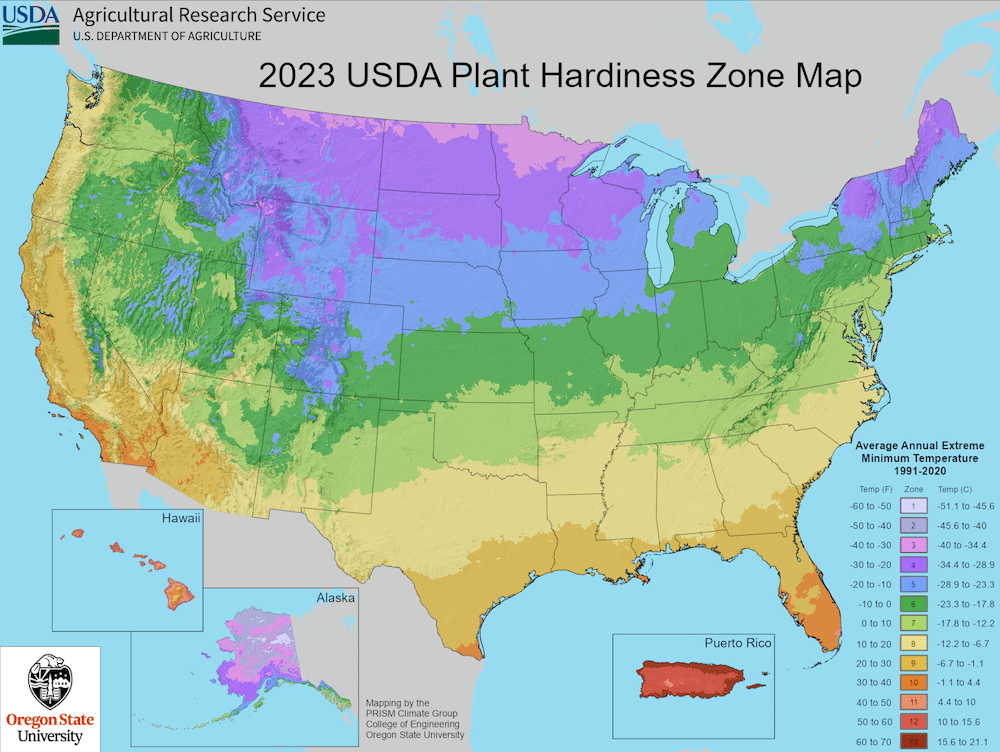
These zones help you know if a plant can handle the winter in your area. For example, a plant that’s good for Zone 4 might not survive the winter in Zone 3, because Zone 3 is colder. If you pick plants that match your zone, they’re more likely to grow well and be healthy because they can handle your winter weather. To find out your zone, simply enter your zip code in the map.
Tip #3: Find native plants based on your Plant Hardiness Zone and region
Native plants offer numerous benefits when it comes to drought-tolerant landscaping. They:
- Are well-adapted to local climate and soil conditions
- Require less supplemental irrigation once established
- Conserve water through deep root systems
- Are more resistant to disease and drought than non-native plants, making them an excellent choice for a sustainable and aesthetically pleasing landscape
There are several ways you can discover native plants that will flourish in your sustainable garden based on your plant hardiness zone and region. Remember incorporating native plants into your landscape can contribute to water conservation, biodiversity, and a healthier ecosystem.

Seek expert advice
Look for a local native plant society or a botanical garden, nursery, garden center or university extension program that specializes in native plants. The staff there can give you advice on what plants do well in your area (i.e. are best suited to your specific zone). Some examples:
- Arizona: The Arizona Native Plant Society
- California: Theodore Payne Foundation
- Colorado: The Colorado Native Plant Society
- Texas and other US States: Despite being based in Texas, the Lady Bird Johnson Wildflower Center website has a comprehensive, searchable database of native plants and suppliers by state. While you’re on the site, be sure to check out the story behind the Wildflower Center.
Shop local
Attend local plant sales, garden shows, outdoor living expos, or gardening clubs, which often focus on plants that thrive in your area. They can be great places to find native plants and get advice from experienced local gardeners. We suggest checking Eventbrite or Meetup for your specific area.
Tip #4: Cluster plants with similar watering needs for a water-efficient garden
Grouping plants based on their watering requirements allows for targeted irrigation. This not only conserves water but also ensures each plant receives the right amount for optimal growth. Here’s how you can do it:
- Research Plant Water Needs: Before you start planting, find out how much water each of your plants requires.
- Group Plants Accordingly: Arrange your plants in groups based on their watering needs. This way, you can water each area according to its specific needs without over- or under-watering any plants.
- Consider Plant Placement: Think about where you’re planting. Areas that naturally receive more water (like low-lying spots or areas near downspouts) are good for drought-tolerant plants that appreciate a little more water like lantana. Drier areas are better for ultra low-water plants like cacti.
- Use Drip Irrigation for Efficiency: Drip irrigation systems can be very effective for watering clustered plants. They deliver water directly to the base of each plant, which reduces water waste and ensures that each plant gets the right amount of water.
- Adjust as Needed: Over time, you might need to move plants around if you notice some are getting too much or too little water. Pay attention to your plants’ health and growth as indicators.
- Mulching: Apply mulch around your plants. Mulch helps retain soil moisture and reduces water evaporation, which is particularly beneficial for grouped plants with similar watering needs.
By following these steps, you can create a more water-efficient garden that caters to the specific needs of your plants, leading to healthier growth, reduced water usage, and a more sustainable garden environment.
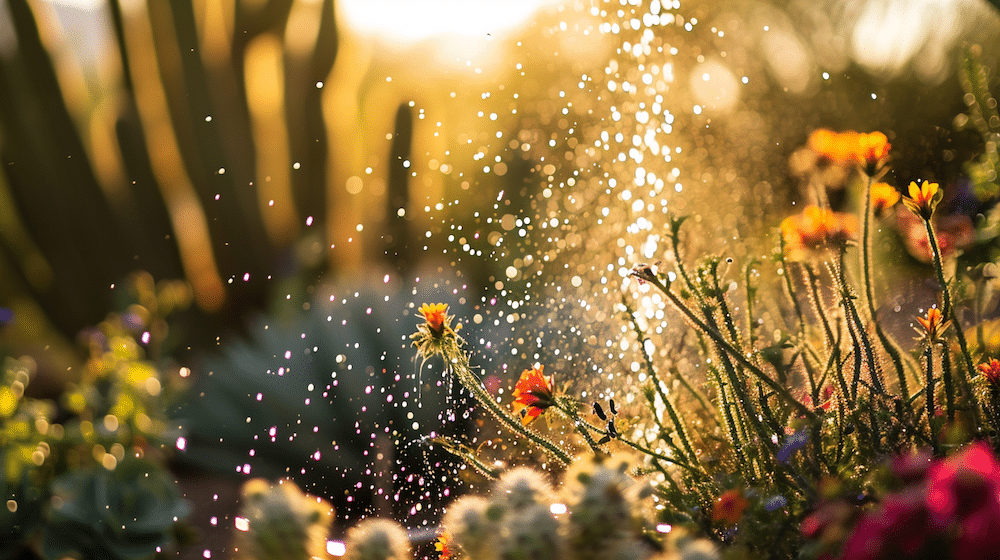
Tip #5: Incorporate permeable hardscape elements
Incorporating permeable hardscape elements like pea gravel, decomposed granite, river stones, mulch, and permeable paving can further reduce water use, while providing visual interest and functionality. Here’s how it works:
- Improved Water Absorption and Percolation: Unlike impermeable surfaces such as concrete or asphalt, permeable materials allow rainwater and irrigation water to filter through them and into the soil. This natural permeation replenishes groundwater supplies and reduces the need for supplemental watering.
- Reduced Runoff and Soil Erosion: When water is unable to penetrate hard, non-porous surfaces, it leads to runoff. This runoff can carry pollutants into water bodies and also contribute to soil erosion. Permeable materials help to mitigate this by allowing water to soak into the ground, thus reducing the amount and speed of runoff.
- Regulation of Soil Moisture Levels: Materials like mulch and decomposed granite help retain soil moisture by reducing evaporation. This means that soil remains moist for longer periods, thereby reducing the frequency of watering needed for plants.
- Temperature Control: Some of these materials, particularly mulch, can help regulate soil temperature, keeping it cooler in hot conditions. Cooler soil retains water better, as less is lost to evaporation.
- Support for Healthy Soil Ecosystem: Permeable materials facilitate the movement of air and water through the soil, which is crucial for maintaining a healthy soil ecosystem. This healthy soil supports plant growth and reduces the need for additional watering and fertilization.
Note that all California turf replacement rebates require mulch or another permeable hardscape to cover bare spaces within project area (i.e. no concrete, decks, etc.). If you live outside of California, check the hardscaping requirements for local rebate eligibility.
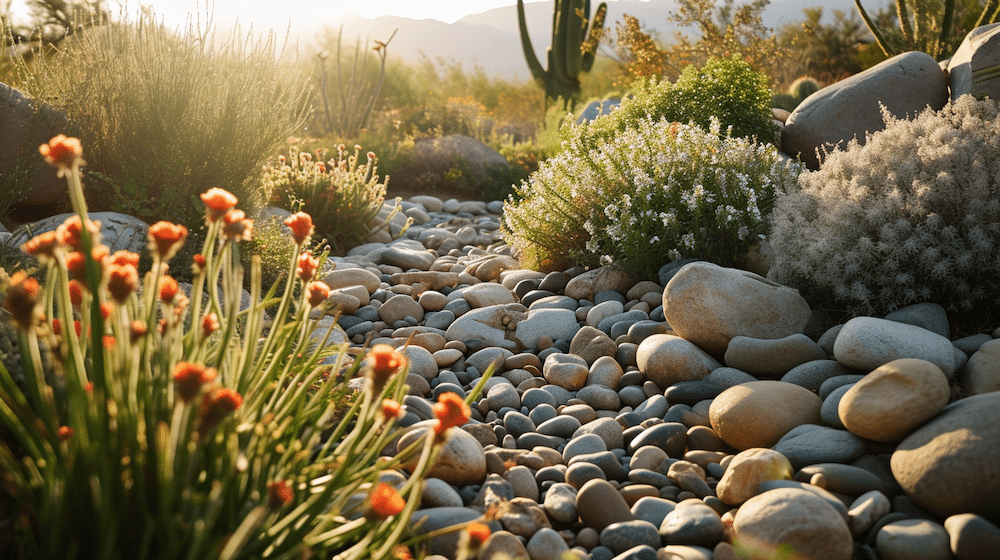
Essential Techniques for Conserving Water in Your Garden
Implementing key water conservation techniques can further enhance the resilience of your drought-tolerant garden. This includes using efficient irrigation methods, such as drip irrigation, and improving your soil structure to help retain moisture and promote healthy root growth. These techniques will be detailed in the subsequent sections to aid you in cultivating a thriving, water-wise garden.
Tip #6 Build a drip irrigation system for efficient watering
Drip irrigation is a method of providing water directly to the ground or soil at a slow rate, using flexible piping to release water gradually and consistently. This method offers several benefits:
- Minimizes water loss through evaporation or runoff
- Ensures that plants receive an even and effective water supply
- Promotes healthier growth
- Increases crop yields
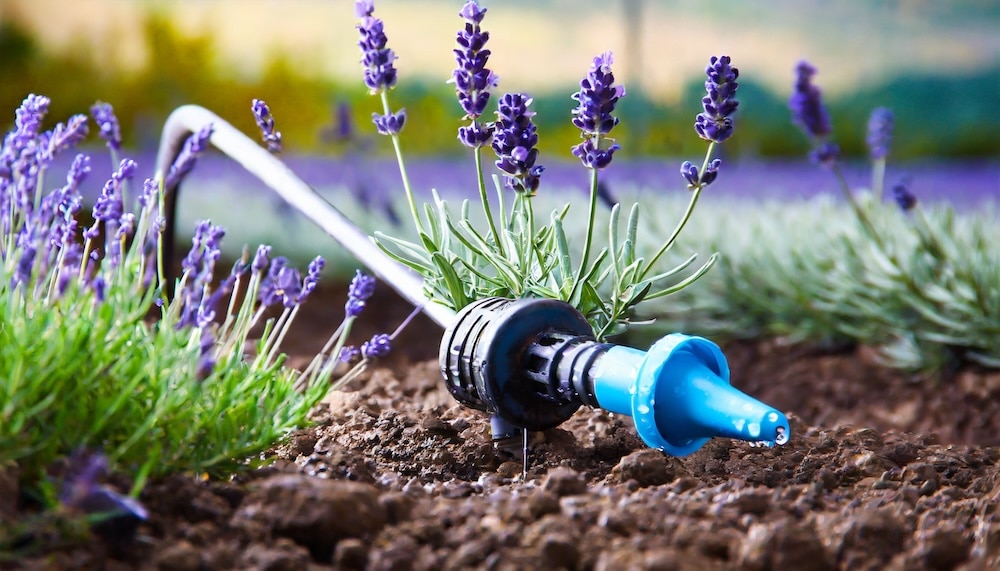
Building a drip irrigation system is an easy job if you know what you’re doing. Trust us, we blew up our first system because we forgot to install a pressure regulator on the hose bib. To learn how to build a drip irrigation system, all you need to do is perform a simple search on YouTube for “diy drip irrigation” or “basic drip irrigation system.”
Building a drip irrigation system is an easy job if you know what you’re doing. Trust us, we blew up our first system because we forgot to install a pressure regulator on the hose bib.
You don’t necessarily need to buy a kit like this. You can purchase the pieces a la carte, which gives you a lot more flexibility and freedom of choice. When you purchase pieces for a drip system, it’s like buying LEGO pieces. You can assemble the pieces any way you’d like, but you want to optimize for your clustered plants.
Tip #7: To make your soil better at holding water, incorporate organic matter such as compost or peat moss
Improving soil structure is essential for retaining moisture in your drought-tolerant landscape. Soil structure affects water retention by influencing how water flows through the soil, with well-structured soil allowing for better water absorption and penetration.
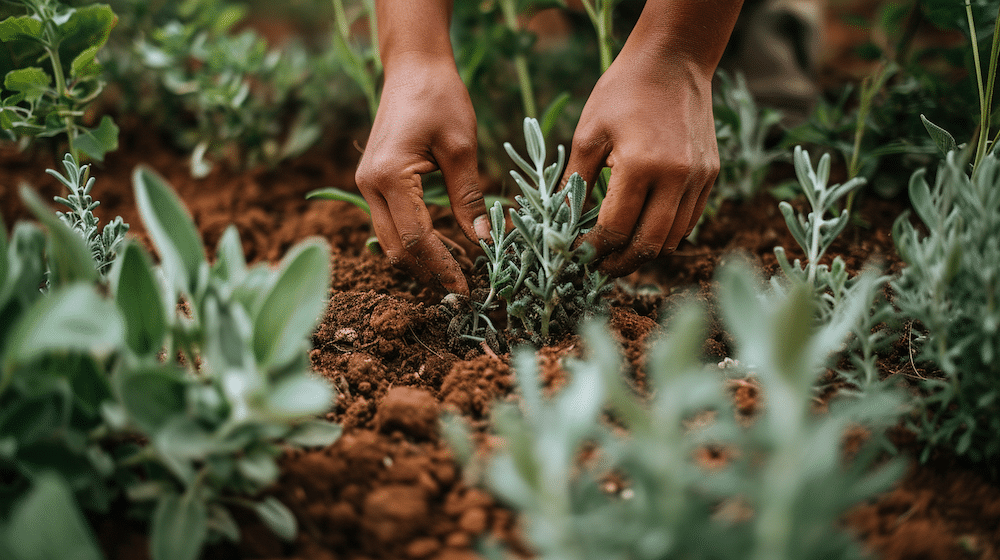
To enhance your soil’s capacity to retain moisture, especially in areas with bare soil, consider incorporating organic matter such as compost or peat moss. These amendments can boost the water-holding capacity of the soil and improve its overall structure.
You can build a compost bin in 5 minutes like this guy:
Or buy a composting robot. Some local agencies even supply free countertop compost pails and pickups if your municipality has a commercial composting facility.
Tip #8: Ensure your plants receive necessary hydration by watering them deeply but infrequently
By irrigating your water-wise plants deeply but infrequently, you allow the soil to dry out between waterings. This encourages deep root growth, which helps plants better tolerate drought conditions. Keep in mind that newly planted drought-tolerant plants still require regular watering, typically once a week during the first year. After this establishment period, they can thrive with only occasional watering.
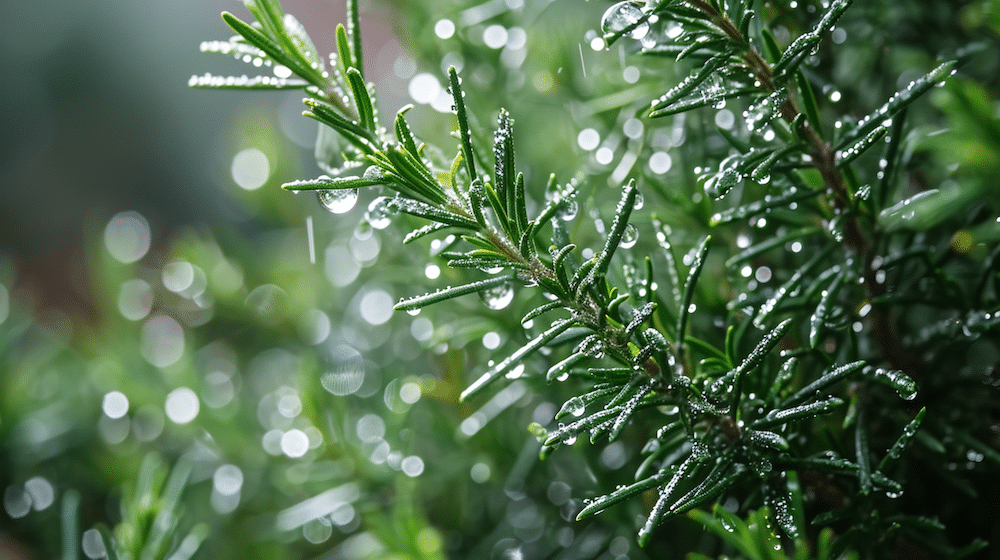
Innovative Ideas for Drought Tolerant Landscaping
You might not think of gardening as being at the forefront of innovation, but we’re here to tell you that it absolutely can be. Adopting innovative ideas for drought-tolerant landscaping can lead to a stunning, sustainable garden that not only conserves water but also supports local ecosystems.
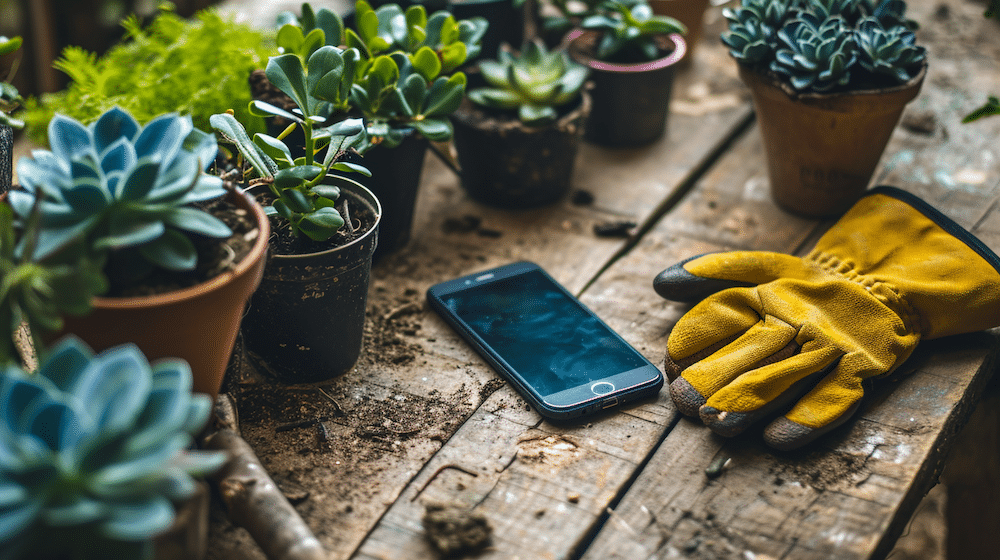
Current trends include:
- Technology: The world of gardening has seen a surge in innovative technologies, making gardening more efficient, productive, and even more enjoyable.
- Smart Irrigation Systems: These systems hook up to your drip irrigation and use weather data and soil moisture sensors to water your garden precisely when needed. They can be controlled via smartphone apps, ensuring your plants get the right amount of water without waste.
- Smart Plant Monitors: These gadgets are placed in the soil next to your plants and can monitor moisture levels, light exposure, temperature, and soil nutrients. The data is sent to your smartphone, helping you keep track of each plant’s needs.
- 3D Printing: The sky’s the limit with a 3D printer! You can create limitless gardening accessories, including the ones featured in this video.
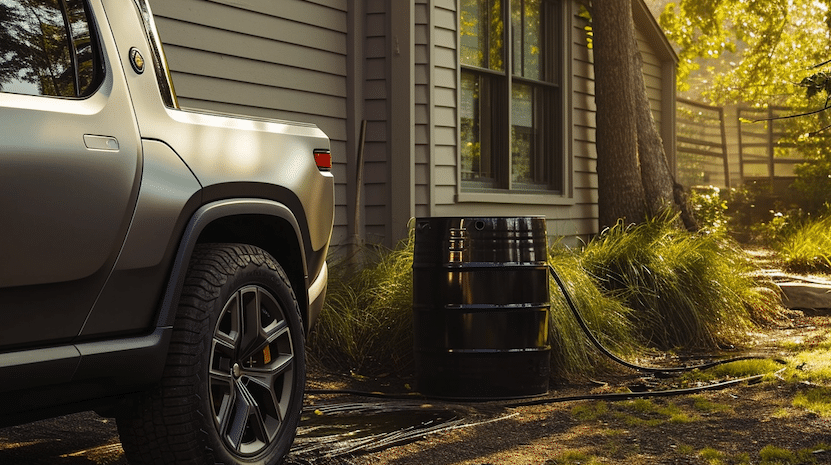
- Rain collection: Collecting and reusing rainwater in your garden is a great way to conserve water and keep your sustainable garden thriving. Here are some innovative and effective ways to do this:
- Rain Barrels: The simplest way to collect rainwater is by using rain barrels. Place them under your gutter’s downspouts to catch water from the roof. This water can then be used for watering your garden. Some rain barrels come with spigots for easy access to the water. Your local water/power agency may even offer a rebate for a rain barrel, like this one in Southern California. Buy one or build one (or even upcycle a garbage can into one), it’s up to you!
- Rainwater Harvesting Systems: For a more advanced setup, you can install a rainwater harvesting system. This involves a larger storage tank, filters, and pumps. These systems can collect a significant amount of water, which can be used for irrigation and, with proper treatment, even household uses.
- Rain Gardens: Creating a rain garden in a low spot in your yard can help collect runoff water. Planting moisture-loving plants in this area can utilize this water effectively.
Summary
In conclusion, creating a lush, low-water garden is achievable with the right drought-tolerant landscaping strategies. By selecting appropriate plants, implementing water-saving techniques, and incorporating hardscape elements, you can conserve water, support local ecosystems, and create a visually appealing outdoor space. Embrace the benefits of drought-tolerant landscaping and transform your yard into a sustainable, thriving oasis.
